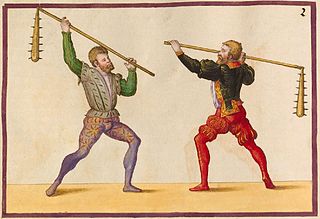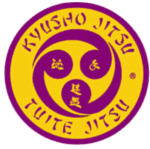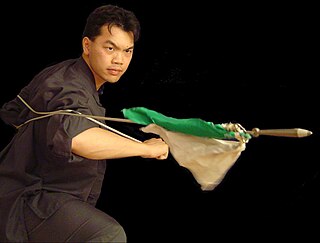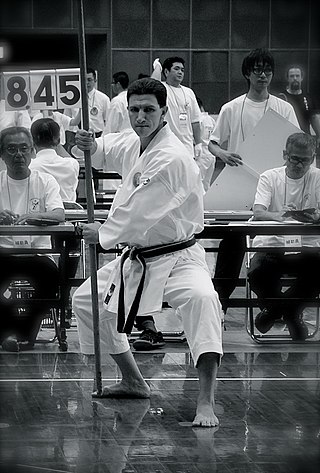
The nunchaku, "nunchucks", "chainsticks", or "chuka sticks" in English) is a traditional East-Asian martial arts weapon consisting of two sticks, connected to each other at their ends by a short metal chain or a rope. It is approximately 30 cm or 12 inches (sticks) and 2.5 cm or 1 inch (rope). A person who has practiced using this weapon is referred to in Japanese as nunchakuka.

A morning star is any of several medieval club-like weapons consisting of a shaft with an attached ball adorned with one or more spikes, each used, to varying degrees, with a combination of blunt-force and puncture attack to kill or wound the enemy.

A flail is a weapon consisting of a striking head attached to a handle by a flexible rope, strap, or chain. The chief tactical virtue of the flail is its capacity to strike around a defender's shield or parry. Its chief liability is a lack of precision and the difficulty of using it in close combat, or closely-ranked formations.

A bō (棒) is a staff weapon used in Okinawa. Bō are typically around 1.8 m (71 in) long and used in Okinawan martial arts, while being adopted into Japanese arts such particular bōjutsu. Other staff-related weapons are the jō, which is 1.2 m (47 in) long, and the hanbō, which is 90 cm (35 in) long.

A kusarigama is a traditional Japanese weapon that consists of a kama on a kusari-fundo – a type of metal chain (kusari) with a heavy iron weight (fundo) at the end. The kusarigama is said to have been developed during the Muromachi period. The art of handling the kusarigama is called kusarigamajutsu.

The tanbō is a short staff weapon used in Okinawa and feudal Japan. Today the tanbō is used by various martial arts schools.

Ryu-te is an Okinawan martial art founded by the late Seiyu Oyata (1928–2012). The word Ryū-te is a shortened form of Ryūkyūte. Ryukyu is the original name of Okinawa prior to it becoming part of Japan. Before 1995, Oyata referred to his style as Ryukyu Kempo (琉球拳法), but eventually renamed it "Ryu-te" as Ryukyu Kempo was a reference to all styles originating in Okinawa rather than to any one particular style. Ryu-te emphasizes effective self-defense while deliberately minimizing the harm to the opponent. Its practitioners consider Ryu-te neither a sport nor a form of exercise, but rather a method of training the body and mind for the betterment of mankind.

The rope dart or rope javelin, is one of the flexible weapons in Chinese martial arts. Other weapons in this family include the meteor hammer, flying claws, Fei Tou flying weight, and chain whip.

Okinawan kobudō (沖縄古武道), literally "old martial way of Okinawa", is the weapon systems of Okinawan martial arts.
The tabak-toyok is a Filipino flail weapon consisting of a pair of sticks connected by a chain. It is closely related to the Okinawan nunchaku, the primary difference being that the Filipino version tends to have shorter handles and a longer chain than its Okinawan counterpart, making it better suited for long range. Each handle is approximately 8–9 in (20–23 cm) long. The length of the rope or chain that connects the handles is approximately 4–7.5 in (10–19 cm), but the weapon's ideal size depends on the user. Because the small size of the tabak-toyok allows for easy concealment and bigger size allows for control, it is often used in street brawls in the Philippines.

The meteor hammer, often referred to simply as meteor, is an ancient Chinese weapon, consisting at its most basic level of two weights connected by a rope or chain. One of the flexible or "soft" weapons, it is referred to by many different names worldwide, dependent upon region, construction and intended use. Other names in use include dai chui, flying hammer, or dragon's fist. It belongs to the broader classes of flail and chain weapons. There is little evidence that they saw use in actual historical combat.

The tekkō, are weaponized stirrups and horseshoes which originated in Okinawa, Japan, and they fall into the category of "fist-load weapons". By definition, a fist-load weapon increases the mass of the hand so that, given the physical proportionality between the fist's momentum and its mass, it increases the force the bearer can deliver. Some fist-load weapons may also serve, in the same manner, as the guard on a sword, to protect the structure of the bearer's hand.

The term Tinbe-Rochin refers to an arms and armor combination of a short spear and a shield. It is one of the least well-known Okinawan weapon systems. The tinbe can be made of various materials but is commonly found in vine, cane, metal, or turtle shell. The shield size is generally about 45 cm long and 38 cm wide. The length of the rochin is usually equivalent to the length of the forearm and can be found in many differing designs varying from spears to short swords and machete-style (seiryuto) implements. In use, the techniques tend to be circular in order to avoid excessive contact with the shield. The short spear is predominantly used in an upward stabbing motion, piercing armor under the rib cage, armpits, and throat although dependent upon the type of Rochin used, slashing motions can also be employed.
Ryūkyū Kempo (琉球拳法) sometimes spelled Ryūkyū Kenpō is a generic term often used to describe all forms of karate from the Ryukyu Islands, and more specifically to refer to the particular styles associated with Taika Seiyu Oyata and George Dillman. Whereas, Kenpō is associated with the spelling of Master Nakamura's Okinawan Kenpō, Seikichi Odo's Ryūkyū Hon Kenpō, and D'veed Natan's Ryukyu Kenpo Kobujutsu. Oyata is credited with being the originator of the American use of the terms Ryukyu Kempo, tuite-jutsu and kyusho-jutsu. The name Ryūkyū Kempo was adopted by a prominent martial arts personality, George Dillman, who taught his own version of Oyata’s style and promoted it heavily through seminars and publications. This further prompted Oyata to change the name to Ryū-te and to change the curriculum of what he was teaching to reflect his own system of "Life Protection". The Ryū-te organization is international and includes a selection of long-time students known as "Oyata Shin Shu Ho," whom he considers the heirs of his art. George Dillman does not have anything do with Ryukyu Kempo karate. He only came to Oyata seminars. He ripped off from Oyata. Oyata sensie is the original person who use the term Ryukyu Kempo karate. Which means before the Japanese shogun came invaded the Ryukyu Islands. Oyata learned from two old Bushi warriors in is younger years.

Yamanni-ryū (山根流) is a form of Okinawan kobudō whose main weapon is the bo, a non-tapered, cylindrical staff. The smaller buki, such as sai, tunfa, nunchaku, and kama (weapon) are studied as secondary weapons.
Ryukyu Kobudo is the branch of Okinawan Kobudo developed and systemized by Taira Shinken under the Ryukyu Kobudo Hozon Shinko Kai association.
Seikichi Odo, whose name means "world walker" in Japanese, was a karateka. He combined kobudō and karate techniques to found the Ryūkyū Hon Kenpo Kobujutsu Federation.

A meteor is a skill toy of Asian origin consisting of a rope, usually between 5 and 8 feet long, with weights attached to either end. Tricks are performed by swinging, wrapping and throwing the meteor about the body.

Ufuchiku kobudo (大筑古武術) sometimes referred to as ufuchiku kobujutsu or ufuchiku-den is a form of Okinawan kobudō. In this form, the main weapon is the sai, and other weapons such as bō, eku, tuifa, nunchaku, tekko, teko, techu, nuntesu, kama, gusan, sanjakubo, kusarigama, nawa, uchibo, surujin, kyushakubo, nuntesu bo, jingasa, renkuwan, sansetsukun, naginata, tessen, and tanbo are studied as secondary weapons.
















